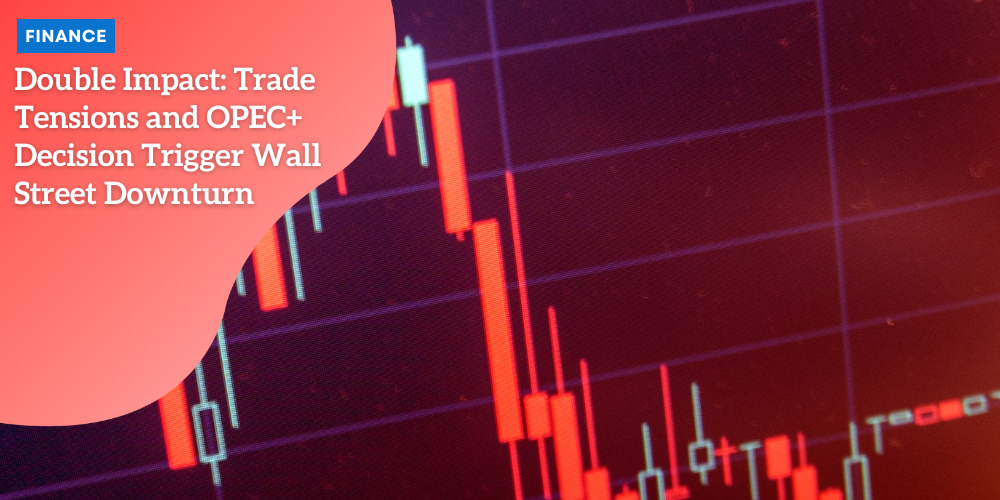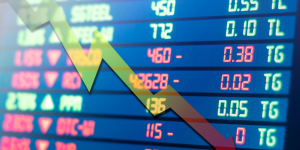Double Impact: Trade Tensions and OPEC+ Decision Trigger Wall Street Downturn

Market Overview: Wall Street’s Recent Downturn
A Stumble After Steady Gains
After a winning streak of nine straight sessions, Wall Street took a sharp turn on May 5, 2025.
Anúncios
The S&P 500 dipped by 0.7%, unwinding recent optimism.
The Dow Jones Industrial Average slipped 0.4%.
This downturn was widespread. More than 75% of listed stocks fell, impacting every sector tracked by the S&P 500.
Anúncios
The losses came all at once, reflecting how sensitive investors are to big headlines and sudden economic shifts.
Even tech and defensive stocks, which often hold up during uncertainty, were not immune this time.
That’s a sign just how broad and deep the market worry runs.
Anúncios

What Triggered the Drop?
Several global events shook investor confidence.
OPEC+ announced it would increase oil production starting June, sending crude prices to their lowest in four years.
This resulted in losses for major energy stocks, with big names like Exxon Mobil hit hard as oil dipped to $57.42 per barrel, a zone that puts pressure on most producers.
At the same time, long-running trade tensions boiled over again.
Newly announced tariffs led to global retaliation and deepened worries about the direction of the world economy.
Markets are struggling to figure out how these quick policy changes will impact corporate profits, consumer prices, and supply chains.
Broad Impact Across Wall Street
This downturn wasn’t limited to a single sector or industry.
With all S&P 500 sectors in the red and three out of four stocks falling, investor nerves were clearly rattled.
The shift comes after a period where markets seemed to shrug off bad news—a reminder that stability can be fleeting in today’s fast-moving, interconnected global economy.
As investors look for clues about what’s next, the intertwining of energy prices, policy shifts, and corporate headlines sets the stage for shifting landscapes across industries.
OPEC+ Decision: Increasing Output and Oil Price Impact
OPEC+ Shakes Up the Oil Market
The oil world felt a jolt when OPEC+ announced a plan to boost oil output by 411,000 barrels per day starting June 1.
This decision caught traders and analysts off guard.
Just hours after the announcement, oil prices plunged to a fresh four-year low. U.S. crude dropped by 1.5%, landing at $57.42 per barrel.
Overnight, the decline was even sharper, reaching up to 4% before leveling off later in the day.
Tough Times for Energy Companies
The dip in oil prices hit energy companies hard.
Most major producers rely on crude oil trading above $60 to remain profitable.
Falling below that threshold, as seen now, is bad news for their bottom line.
On Wall Street, energy stocks suffered noticeable losses.
For instance, Exxon Mobil shares slumped by 2.4%.
The larger selloff reflected growing concerns about whether firms can stay in the black as prices fall further.
Why This Matters for Markets
This oil price drop did more than rattle the energy sector.
Investors worried about the ripple effects for the broader economy.
Lower oil prices can signal slowing economic demand or excess supply, both of which make investors uneasy.
The sharp drop added to the negative sentiment already weighing on the market after a long winning streak.
OPEC+’s surprise move, mixed with existing market uncertainty, sent a strong signal:
global economic conditions are still fragile, and sudden policy shifts can have outsized impact across financial markets.
This ripple from the oil patch set the stage for deeper market unease, priming traders and analysts for further surprises ahead.
| Scenario | Before | After (Leadership Change) |
|---|---|---|
| 👨💼 CEO Leadership | Warren Buffett as CEO for over six decades | Buffett steps down, remains as chairman, leading to investor uncertainty |
| 📉 Stock Market Reaction | Steady market presence | Berkshire Hathaway shares drop by 5.5% amid leadership change |
| 🌍 Market Conditions | Stable global policies and oil production | Increased OPEC+ oil production and rising trade tensions affecting markets |
| 📈 Leadership Transition | Buffett’s strong leadership tied to the company’s success | Anxieties about succession as Berkshire adapts to new leadership |
| 🔮 Future Outlook | Clear direction under Buffett’s leadership | Uncertainty about future direction amid leadership change and market turbulence |
Trade Tensions: Trump’s Tariff Policies and Global Response
An Evolving Trade War
Markets are no strangers to volatility, but recent moves by President Trump have taken uncertainty to another level.
The administration’s decision to impose tariffs on a wide range of imported goods has had ripple effects across the globe.
While some of the more severe tariffs slated for April were pushed back by three months, those targeting Chinese imports stayed in place.
This gave Wall Street a small reprieve but hasn’t calmed overall nerves.
Unpredictable shifts in policy keep everyone guessing, from small business owners to multinational conglomerates.
Global Retaliation and Economic Uncertainty
It didn’t take long for other countries to respond.
After the initial wave of U.S. tariffs, global trading partners fired back with their own penalties.
China, in particular, accused the U.S. of economic bullying and showed no signs of backing down.
This tit-for-tat escalation raised concerns about higher costs for consumers and disrupted supply chains worldwide.
Investors, sent reeling by the constant back-and-forth, saw markets swing rapidly as the economic outlook grew foggier by the day.
Businesses struggled to plan for the future, with many unsure if new tariffs would suddenly appear or be delayed without warning.
Impact on Market Stability
The on-again, off-again nature of trade announcements left economists and traders on edge.
Intermittently delayed tariffs provided short bursts of optimism, only to be followed by sharp selloffs when the situation worsened.
As companies scrambled to adjust, the uncertainty itself became a new kind of risk.
Treasury yields remained relatively stable, but the sense of unease about long-term growth persisted.
As these global forces play out, attention also turns to monetary policy, which faces new challenges in an unpredictable trading environment.
Federal Reserve’s Position: Monetary Policy Amid Uncertainty
Navigating a Shifting Economic Landscape
Amid trade tensions and surprising oil market movements, all eyes have turned to the Federal Reserve.
The central bank faces a tough landscape shaped by tariffs, leadership changes, and falling oil prices.
With inflation floating just above the 2% target, concerns are rising about how persistent global trade disputes might further complicate the economic picture.
Interest Rates in Focus
The Fed is widely expected to maintain its benchmark interest rate at the upcoming meeting.
After cutting rates three times in 2024, the central bank has adopted a more cautious approach.
This stems from conflicting signals—while inflation has cooled, it continues to hover above target.
At the same time, economic forecast models are thrown off by the on-again, off-again nature of tariffs and trade policies, especially those directed at China and other major trading partners.
This uncertainty makes the Fed’s decision tricky.
Sudden moves risk fueling inflation or slowing the economy just as businesses and households need stability the most.
As tariffs shift rapidly, sometimes daily, the Fed’s role as an anchor becomes more challenging.
Markets Remain Edgy
Despite these pressures, certain indicators have stayed fairly steady.
For example, the 10-year Treasury yield inched up slightly, moving to 4.32% from 4.31%.
This suggests investors aren’t expecting major changes soon, but it doesn’t erase the underlying sense of unease across Wall Street.
Businesses and economists alike are on edge, watching for signs from the Fed about the next steps.
Uncertainty has become the new normal, and the interplay of trade, rates, and volatility keeps everyone guessing as new developments unfold.
Economic Outlook: Navigating Geopolitical and Market Challenges
Rising Uncertainty and the Market Response
The relationship between global events and market performance has rarely felt so unpredictable.
Recent turmoil—from oil market shifts to new rounds of tariffs—has left businesses and investors scratching their heads.
The day after OPEC+ revealed a plan to increase oil production, oil prices plunged to a four-year low.
Stocks across the board dropped, with about 75% of S&P 500 companies posting losses.
This financial anxiety isn’t just about oil.
Trade disputes, especially tariffs imposed by the U.S., have triggered global responses and led to shifting rules every week.
Some tariffs got delayed, but uncertainty lingers because key tariffs against China have stayed in place.
For businesses and economists, these rapidly changing policies make forecasting almost impossible.
Businesses, Economists, and Policy Instability
Companies are now having to deal with the near-constant risk that new regulations or tariffs might disrupt their supply chains or increase their costs.
Many business leaders are holding off on big investments. Economists, too, are struggling to predict how these global disruptions will affect hiring, consumer spending, and growth.
Despite this background noise of instability, not every indicator is flashing red. Treasury yields, particularly the 10-year note, have barely budged.
Even after the recent market drop, yields edged up to just 4.32% from 4.31% the previous week.
As global headlines continue to drive the economic conversation, the pressure on policymakers and investors is unlikely to ease anytime soon.





